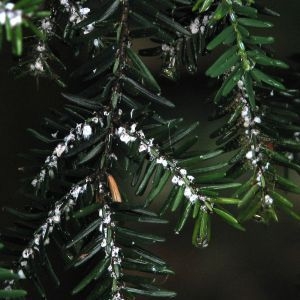 (Host) The recent discovery of hemlock woolly adelgid in a sixth Windham County town is bad news for the region’s forests.
(Host) The recent discovery of hemlock woolly adelgid in a sixth Windham County town is bad news for the region’s forests.
The insects have devastated hemlocks in areas south of New England, especially Appalachia.
But scientists have reasons to hope the damage could be less severe here.
VPR’s Susan Keese has more.
(Keese) The hemlock woolly adelgid is a tiny bug that sucks the juices from hemlock twigs until the needles turn yellow and fall.
The easiest way to spot it is to look for little cottony white masses under twigs and at the bases of needles.
Jim Esden, a forester with the Vermont Department of Forests, Parks, and recreation has been training citizens in southern Vermont to scour forests and lawns for signs of the pest.
(Esden) "The finds that have been made in Dummerston were all made by volunteers."
(Keese) The insects have also been found in Vernon, Brattleboro, Townshend, Jamaica and last week Guilford joined the list.
Some foresters have warned of a disaster comparable to the chestnut blight, which wiped out an important forest species early in the 1900’s.
Hemlock is Vermont’s seventh most common tree. The shade-tolerant evergreen helps cool woodland streams so that trout can flourish, and provides winter habitat for deer.
But Esden says the insect doesn’t seem to be killing trees as quickly in the colder regions as in Appalachia – even though it leaves them weak and vulnerable to other stresses.
(Esden) " Hemlock woolly adelgid is here, that’s true, but I believe that the winter temperatures just kind of continually whittle away at the population of adelgids and seems to be keeping the levels of population low enough so that they can’t wipe the trees out real quickly."
(Keese) Barbara Burns is a forest health specialist for the state.
(Burns) "The down side of that is that it is becoming cold tolerant as it moves north. They’ve done some research at the University of Vermont demonstrating that hemlock woolly adelgid is more cold tolerant in central New England than the insects on the southern coast of New England."
(Keese) Still, Burns agrees that time is on Vermont’s side, and that it’s premature to start destroying hemlocks in a panic. The insect can be controlled on lawn trees.
And Burns says researchers at UVM are studying a fungus that attacks the pest.
Scientists are also considering introducing a beetle that devours woolly adelgid on hemlocks in Idaho, where the insect exists, but rarely kills trees.
(Burns) "Hemlock woolly adelgid is not considered a major forest pest in the Pacific Northwest, and so we’re looking at what keeps it in check out there to help us here in the East."
(Keese) Vermont, Maine and New Hampshire have also instituted quarantines on nurseries prohibiting the transport of hemlocks from infested areas.
For VPR News, I’m Susan Keese.